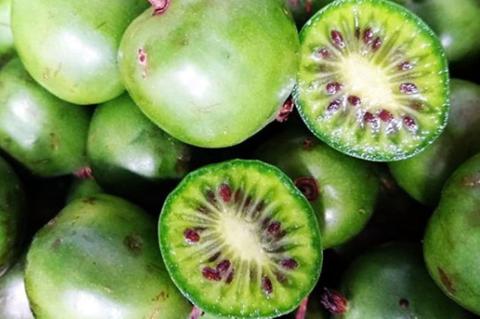Key Findings

UNH's kiwiberry breeding program is the only one in the nation – and the first in the world – to develop genetic identification and selection procedures for the crop.
The program has systematically evaluated the North American collection of kiwiberries and developed a needed method of variety verification for the nursery trade.
The program has evaluated over 4,000 potential new varieties and advanced 29 elite selections to replicated trials.
At least 5 commercial kiwiberry operations have been established in the Northeast because of research at UNH.
About the Author

Iago Hale, Associate Professor of Agriculture, Nutrition, and Food Systems; learn about New England kiwiberries online at Nor'East Kiwiberries
Contact information: Iago.Hale@unh.edu
603-862-4653
This research was published in the INSPIRED: A Publication of the New Hampshire Agricultural Experiment Station (Summer 2022)
Researchers: I. Hale
Today, the commercial blueberry market is a $4 billion global industry, but the berry has been commercially produced for less than a century. In large part, the success of the blueberry was due to public sector scientists recognizing the fruit's potential and initially undertaking the research necessary to lay the groundwork for commercialization. Such exploratory work remains essential today in order to prepare for the uncertainty of future environmental and food security challenges. The kiwiberry—a small, grape-sized kiwi-like fruit—could be the next blueberry for the Northeast.
What is a kiwiberry?
Introduced to the Northeast in the 1870s and grown widely as a backyard and garden plant throughout the region for nearly 150 years, the kiwiberry (Actinidia arguta) shows great potential for commercial success. The plant is a woody perennial climbing vine that produces clusters of small, grape-sized kiwi-like fruit. Due to high levels of carotenoids and anthocyanins, the nutritious flesh of a kiwiberry can assume a wide range of attractive colors, from dark greens to yellows to reds to purples. The fruit is high in vitamin C and one of the richest. sources of lutein (an antioxidant) in commonly consumed fruits.
Another promising aspect for commercialization is the fact that the berries are hairless. This characteristic, along with a thin, palatable skin, means the fruit can be consumed directly and conveniently without peeling, like other economically successful berries (grapes and blueberries, among others). Finally, with sugar levels on par with wine grapes (>20°Brix), citrus-level acidity and tropical notes reminiscent of mango and pineapple, the kiwiberry has a well-balanced sweet-tart flavor profile. With the proven commercial viability of a handful of pioneering kiwiberry farms in the Northeast, these merits combine to recommend the kiwiberry for strategic investment in genetic improvement, establishment of best production practices and development of a market.
Kiwiberry research at UNH
With their attractive appearance, intense and complex flavor profiles, high levels of bioactive compounds, easy consumability and adaptation to the region, kiwiberries are an economically promising fruit for New England producers. Since 2013, the kiwiberry research and breeding program at the NH Agricultural Experiment Station has had a mission to realize that promise for the state.
Plant breeding is a numbers game. The more plants that can be grown and evaluated, the more likely it is that one will discover superior varieties. But the kiwiberry presents a challenge. At commercial spacing, a single kiwiberry vine requires roughly 100 square feet of field space, limiting the number of plants that an acre of research can support compared to other crops (for example, a mere 400 kiwiberry vines versus ~1 million wheat plants per acre). Additionally, like many woody fruiting species, it takes several years before a kiwiberry vine reaches reproductive maturity to produce flowers and fruit.
The consequences are twofold. First, because flowers are required for fruit production, it takes many years before a vine can be evaluated for fruit quality. Second, because any given kiwiberry vine is either male (pollen-producing) or female (fruit-producing), years can be spent evaluating vines only to find, once they flower, that half of them are male and thus of no interest to the program. The result is that effective population sizes are cut in half—a major obstacle to progress.
To overcome this challenge, targeted genomic characterization methods (DNA sequencing) were developed to determine a kiwiberry vine's gender at seed germination. Through such marker-assisted selection, female vines can be identified and transplanted to the field, effectively doubling population size on the same area of land. Additionally, through innovative canopy management, the planting density of breeding populations was increased, allowing nearly seven times the number of vines on the same amount of land. And through implementing rigorous vine management protocols (pruning, irrigation and fertilization), the program reduced the average flowering time from 5-6 years to just 3 years, effectively doubling the number of vines that can be evaluated in a given time period.
These innovations have led to a 30-fold increase in research efficiency, allowing the research program to screen thousands of potential kiwiberry varieties within the 1.5-acre research vineyard at the Woodman Horticultural Research Farm. With this gain in efficiency, replicated trials are being conducted to choose varieties that exhibit reliably superior characteristics. The assessments include fruit quality (berry size, appearance, sugar content, texture, flavor, storability and ripening behavior) and production traits (overall vigor, cold tolerance, flowering and generation time, water stress tolerance and yield). So far, nearly 30 selections have been advanced to replicated trials and the prospect of releasing new elite varieties to support this emerging industry is coming to fruition.




